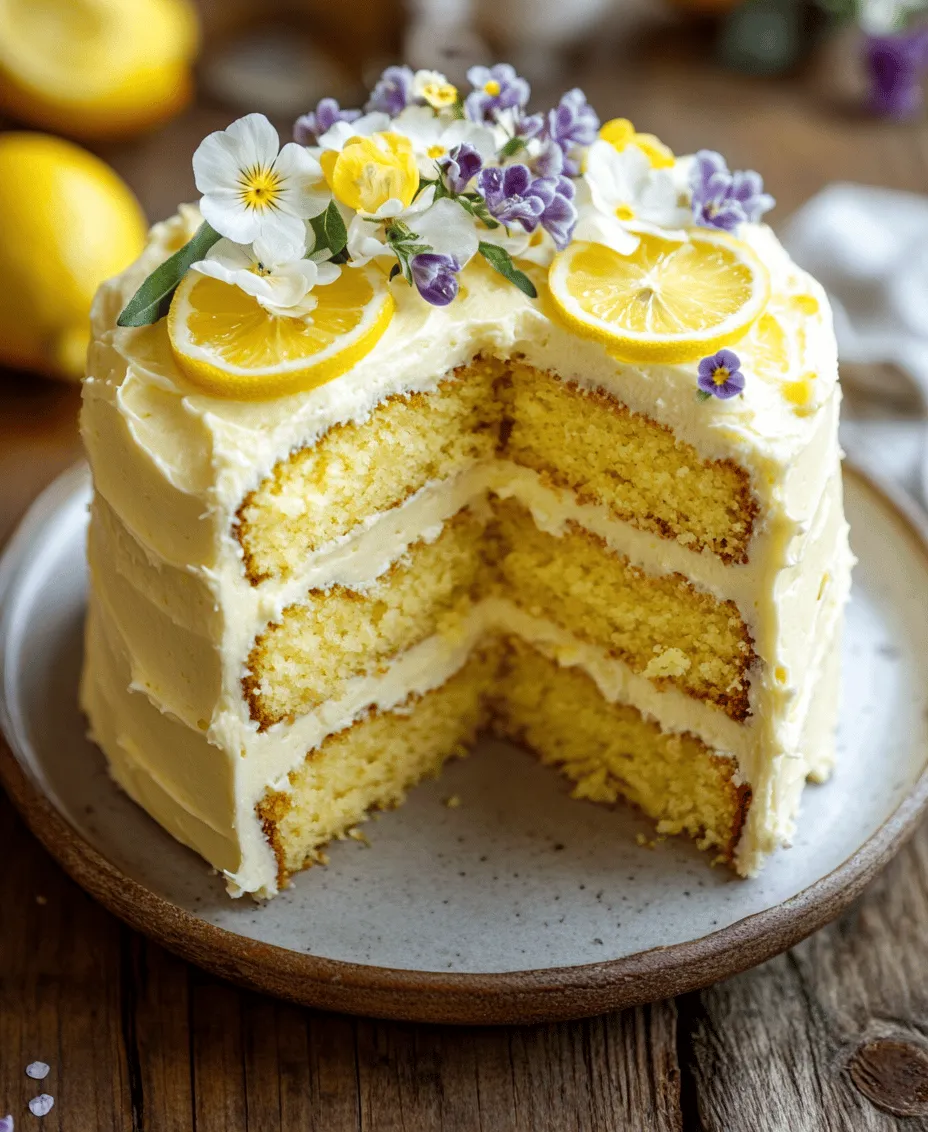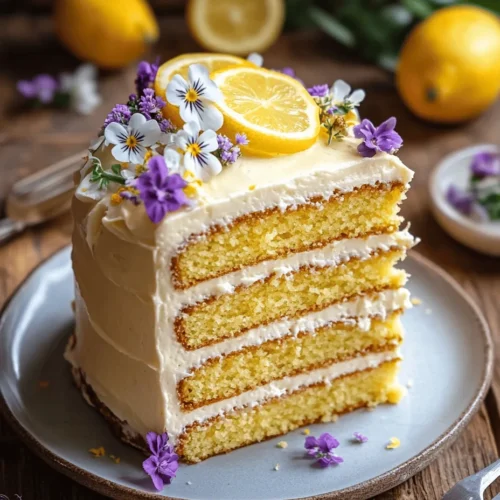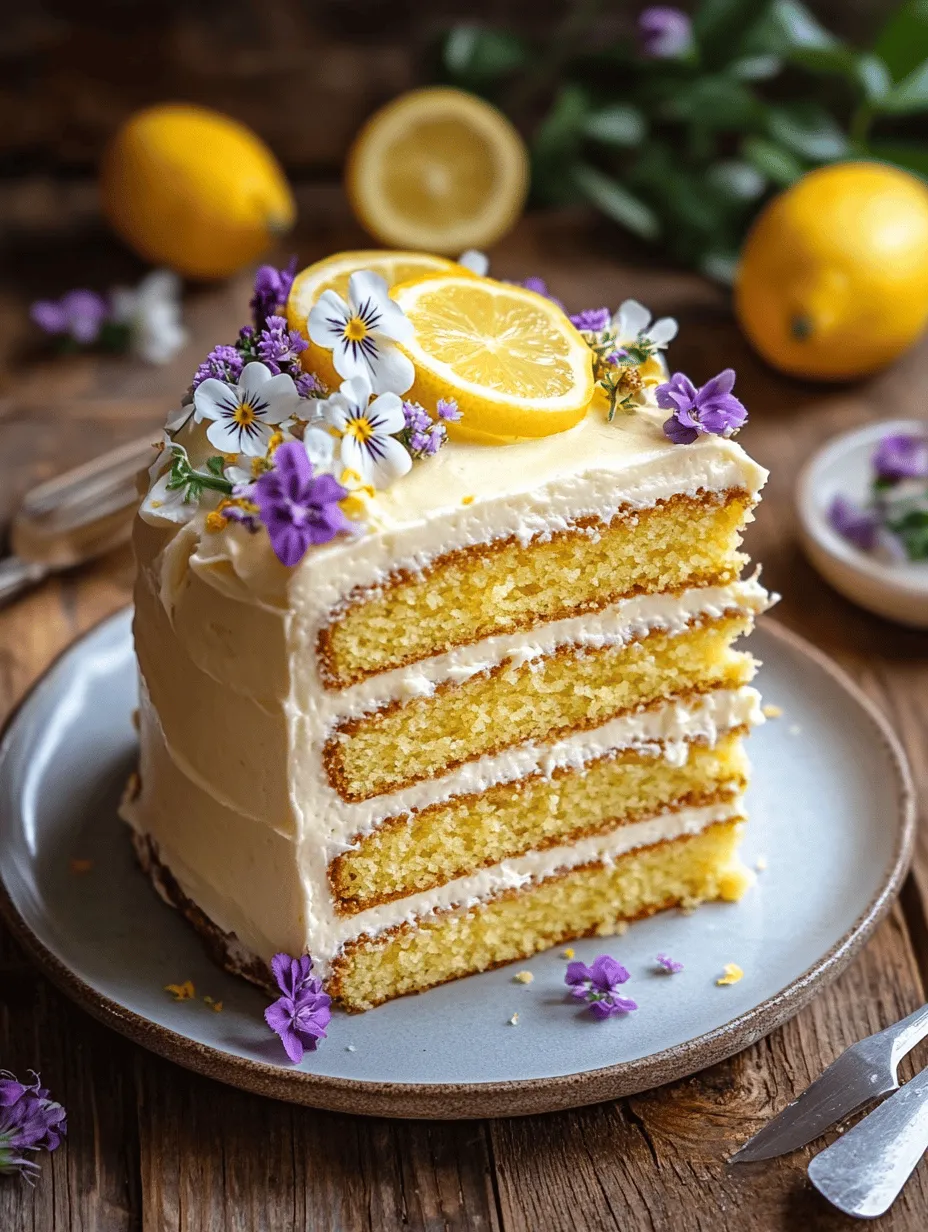Introduction
Imagine a cake that captures the essence of sunny days, with a flavor so bright it can lift anyone’s spirits. The Lemon Velvet Layer Cake is just that—a delightful treat that combines the soft, moist texture of velvet cake with the refreshing zing of lemon. This cake is perfect for various occasions, from birthday celebrations to afternoon tea parties, making it an ideal centerpiece for gatherings where you want to impress your guests with both flavor and presentation.
Using fresh ingredients is paramount in baking, especially when it comes to enhancing flavors. The star of this cake, the lemon, plays a crucial role—not only does it provide a vibrant taste, but it also infuses the cake with a beautiful, sunny color that makes it visually appealing. Whether you’re a seasoned baker or a novice in the kitchen, this recipe offers an opportunity to create something truly special that can brighten anyone’s day.
The Charm of Lemon Velvet Layer Cake
The Lemon Velvet Layer Cake stands out not just for its flavor but also for its exquisite texture. The cake is soft, airy, and delicately crumbly, reminiscent of classic velvet cakes. When you take a bite, you are greeted with a harmonious balance of sweetness and tartness, which makes each slice a delightful experience. The cake’s golden hue, combined with its creamy frosting, makes it a feast for the eyes, elevating the overall presentation.
Historically, lemon cakes have been a staple in baking traditions across cultures. The bright, zesty flavor of lemons has long been cherished for its ability to uplift even the simplest of desserts. In England, for instance, lemon cakes were often enjoyed during tea time, while in the United States, lemon desserts have become synonymous with summer picnics and festive gatherings. The Lemon Velvet Layer Cake encapsulates this rich history while adding a modern twist, making it a versatile choice for any occasion.
This cake is not only a treat for your taste buds but also a stunning centerpiece that can elevate any celebration. Whether you are hosting a birthday party, a bridal shower, or simply enjoying a weekend gathering with friends, the Lemon Velvet Layer Cake is sure to impress. Its vibrant color and delectable flavor make it a favorite among both children and adults alike, ensuring that it will be a hit at your next event.
Ingredients Breakdown
Before diving into the baking process, it’s essential to understand the role of each ingredient in the Lemon Velvet Layer Cake. Each component contributes to the cake’s overall texture, flavor, and structure.
– All-Purpose Flour: This ingredient is the backbone of the cake, providing the necessary structure and texture. The gluten in the flour helps the cake rise while maintaining a tender crumb.
– Baking Powder and Baking Soda: These leavening agents are crucial for giving the cake its light and airy quality. Baking powder works by creating carbon dioxide gas when it comes into contact with moisture and heat, while baking soda requires an acidic component—like lemon juice or buttermilk—to activate.
– Salt: A small amount of salt enhances the overall flavor of the cake, balancing the sweetness and bringing out the natural flavors of the other ingredients.
– Unsalted Butter: This ingredient adds creaminess and moisture to the cake. Using unsalted butter allows for better control over the cake’s flavor, as you can adjust the salt content according to your preference.
– Granulated Sugar: Sugar not only sweetens the cake but also contributes to its texture. It helps to create a moist crumb by retaining moisture during baking and adds to the cake’s overall structure.
– Eggs: Eggs serve multiple purposes in this recipe. They act as a binding agent, helping to hold the cake together, and also add richness and moisture, contributing to the cake’s velvety texture.
– Buttermilk: This ingredient is key in creating a tender cake. The acidity of buttermilk reacts with the baking soda, helping the cake rise while adding a slight tanginess that complements the lemon flavor.
– Vanilla Extract: While lemon is the star, vanilla extract adds depth to the cake’s flavor profile, enhancing the overall taste experience.
– Lemon Zest and Juice: Freshly grated lemon zest and juice are essential for achieving that bright, zesty flavor that defines this cake. The zest provides aromatic oils that intensify the lemon flavor, while the juice adds moisture and acidity.
– Optional Decorations: To elevate the visual appeal of the Lemon Velvet Layer Cake, you may choose to add decorations such as candied lemon slices, edible flowers, or a dusting of powdered sugar. These not only enhance the presentation but also add an extra layer of flavor.
Step-by-Step Instructions
Now that you have a comprehensive understanding of the ingredients, it’s time to move on to the baking process. The following steps will guide you through creating the perfect Lemon Velvet Layer Cake.
Preheating the Oven and Preparing Pans
The first step in baking a successful cake is preheating your oven. Set it to 350°F (175°C). This ensures that the cake begins baking at the right temperature, allowing it to rise properly. While the oven is preheating, prepare your cake pans. Grease two 9-inch round cake pans with butter or non-stick spray, and line the bottoms with parchment paper for easy removal after baking. This preparation is crucial for achieving a clean release from the pans, preventing any potential sticking that could mar your beautiful cake.
Mixing the Dry Ingredients
Once your pans are ready, it’s time to mix the dry ingredients. In a large mixing bowl, combine the all-purpose flour, baking powder, baking soda, and salt. Whisk these ingredients together until they are evenly distributed. This step might seem simple, but it is vital for ensuring an even rise in your cake. Properly mixing the leavening agents helps to prevent any lumps, allowing for uniform distribution throughout the batter.
By taking the time to mix the dry ingredients thoroughly, you set the foundation for a light and fluffy Lemon Velvet Layer Cake that will impress anyone who takes a bite.
Conclusion
The Lemon Velvet Layer Cake is a delightful recipe that brings together the bright flavors of lemon with the soft texture of a velvet cake. By using fresh ingredients and following the step-by-step instructions provided, you’ll be well on your way to creating a stunning dessert that will elevate any occasion. In the next part of this article, we will continue with the remaining steps of the recipe, including the mixing of wet ingredients and the baking process. So, prepare to roll up your sleeves and get ready for a baking adventure that will surely brighten your day!

Creaming Butter and Sugar
The creaming method is a fundamental technique in baking that plays a pivotal role in achieving the desired texture for your Lemon Velvet Layer Cake. This technique involves beating together softened butter and sugar until the mixture is light and fluffy. The air incorporated during this process helps to create a tender and airy cake, providing the perfect base for your lemony layers.
To cream the butter and sugar effectively, start with room temperature butter. This ensures that it blends seamlessly with the sugar, resulting in a smooth mixture. Use an electric mixer on medium speed for about 3 to 5 minutes, scraping down the sides of the bowl as needed. The goal is to achieve a pale, fluffy consistency that signifies enough air has been incorporated. This step is crucial, as it not only impacts the cake’s texture but also its overall rise during baking.
Incorporating Eggs and Wet Ingredients
Once the butter and sugar are creamed to perfection, it’s time to incorporate the eggs and wet ingredients. Adding eggs one at a time allows for better emulsification, ensuring that the mixture remains smooth and cohesive. Beat each egg in thoroughly before adding the next; this step is essential for creating a uniform batter. Additionally, incorporating wet ingredients like milk or buttermilk adds moisture and richness to the cake, balancing the sweetness of the sugar.
Mixing techniques are vital at this stage. You want to fold the wet ingredients into the creamed mixture gently, ensuring everything is well-combined without overmixing. Overmixing can lead to a dense cake, which is the opposite of what we want for our Lemon Velvet Layer Cake. Aim for a smooth batter that maintains an airy quality—this is key to achieving that light, velvety texture.
Combining Wet and Dry Ingredients
The next step involves combining your wet and dry ingredients. Start by sifting together your dry ingredients, including flour, baking powder, and salt. This process not only aerates the flour but also helps eliminate lumps, leading to a smoother batter.
When folding in the dry ingredients, do so in stages. Add one-third of the dry mix to the wet mixture, gently folding it in with a spatula. Alternate with a portion of the remaining wet ingredients, and continue this process until all ingredients are incorporated. Be cautious not to overmix—stop as soon as there are no visible streaks of flour. This technique helps maintain the cake’s fluffiness and ensures it rises beautifully in the oven.
Baking the Cake
Preheat your oven to 350°F (175°C) and prepare your cake pans by greasing and lining them with parchment paper. This will prevent any sticking and ensure easy removal after baking. Pour the batter evenly into the prepared pans, filling them about two-thirds full to allow for rising.
Baking times can vary depending on your oven and the size of your pans, but generally, you should bake the cakes for about 25 to 30 minutes. To check for doneness, insert a toothpick into the center of the cake. If it comes out clean or with a few moist crumbs, the cake is ready. Avoid opening the oven door too soon, as sudden temperature changes can affect the cake’s rise.
Cooling the Cakes
Once baked, it’s crucial to cool the cakes properly before frosting. Allow them to cool in the pans for about 10 minutes, then carefully remove them and transfer them to a wire rack. Let the cakes cool completely. This cooling process is vital for achieving the right texture for frosting; if the cakes are still warm, the frosting can melt, resulting in a gooey mess instead of a beautifully layered cake.
Frosting Options for Your Lemon Velvet Cake
Frosting is where you can get creative and elevate your Lemon Velvet Layer Cake. Here are some popular options to consider:
Cream Cheese Frosting: Tangy and Rich
Cream cheese frosting offers a deliciously tangy and rich topping that pairs beautifully with lemon flavors. To make this frosting, beat together cream cheese, softened butter, powdered sugar, and a splash of vanilla extract until smooth and creamy. The tanginess of cream cheese complements the sweetness of the cake, creating a delightful balance.
Whipped Cream Frosting: Light and Airy
If you prefer a lighter option, whipped cream frosting is an excellent choice. Simply whip heavy cream with powdered sugar and a touch of vanilla until soft peaks form. This airy frosting is perfect for a fresh, summery feel and allows the lemon flavor to shine without being overly sweet.
Buttercream Frosting: Classic and Versatile
Buttercream frosting is a classic choice for any cake. For a lemon twist, add lemon juice and zest to the buttercream base. Beat together softened butter, powdered sugar, and lemon juice until smooth and fluffy. This frosting is not only delicious but also versatile, as you can tint it or flavor it further to match your theme.
Tips for Achieving the Perfect Frosting Consistency
Regardless of the frosting you choose, achieving the right consistency is key. For buttercream, it should be spreadable but firm enough to hold its shape. If your frosting is too stiff, add a teaspoon of milk at a time until you reach the desired consistency. Conversely, if it’s too thin, add more powdered sugar. For whipped cream, ensure you don’t over-whip, as it can turn grainy. Aim for soft peaks that hold their shape without collapsing.
Decorating Ideas
Decorating your Lemon Velvet Layer Cake can be a fun and expressive part of the baking process. Fresh lemon slices can be used to adorn the top, providing an elegant look while reinforcing the lemon flavor. Additionally, consider using edible flowers, such as pansies or nasturtiums, to add a pop of color and a touch of sophistication. These flowers not only enhance the visual appeal but also bring a subtle, fresh flavor that complements the cake wonderfully.
Another creative idea is to create a lemon glaze using powdered sugar and lemon juice. Drizzle this glaze over the top of the frosted cake for a glossy finish and an extra tangy kick. You can also add lemon zest on top of the frosting for a beautiful contrast and added flavor.
Serving Suggestions
The Lemon Velvet Layer Cake is versatile and can be enjoyed on various occasions. For a delightful afternoon treat, serve slices with a cup of freshly brewed tea or coffee. The bright flavors of lemon pair wonderfully with both, making for a refreshing experience.
For special occasions like birthdays or holidays, consider pairing the cake with sparkling lemonade or a citrus-infused cocktail. The bright, zesty flavors of the cake will complement the refreshing beverages, enhancing the overall experience.
If you’re hosting a summer gathering or picnic, this cake can be the centerpiece of your dessert table. Serve it alongside fresh fruit, such as berries or a fruit salad, to add a colorful and fruity touch that balances the cake’s richness.
Conclusion
Baking a Lemon Velvet Layer Cake is not just about creating a delicious dessert; it’s about the joy of the process and the satisfaction of sharing your creation with others. Each step, from creaming the butter and sugar to decorating the cake, allows you to express your creativity and baking skills.
This cake’s bright lemon flavor and velvety texture make it a timeless addition to any dessert menu, perfect for celebrations or quiet moments at home. Encourage yourself to try this recipe and enjoy the process—the result will be a stunning cake that brings smiles and compliments to your table.
As you explore the world of baking, embrace the versatility of lemon desserts. They are not only delightful to eat but also evoke a sense of nostalgia and joy, making them a cherished part of culinary experiences across generations. So gather your ingredients, preheat your oven, and embark on a delightful baking adventure with this Lemon Velvet Layer Cake.


